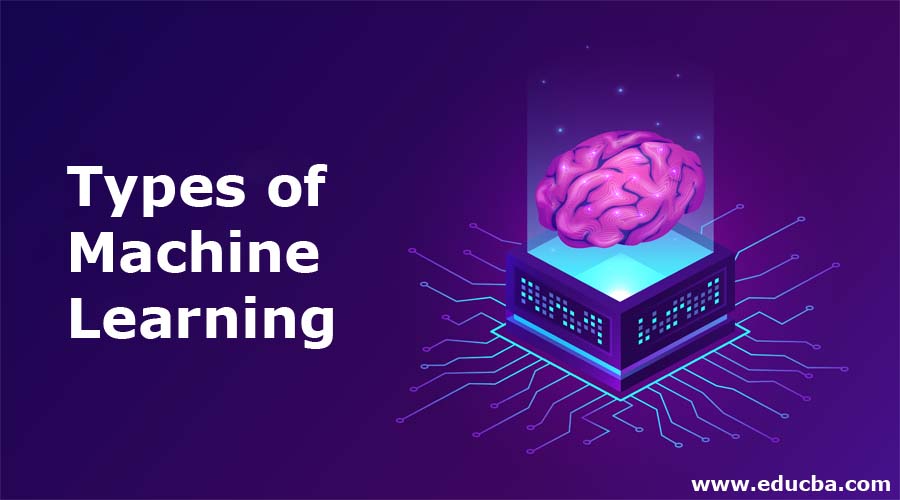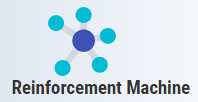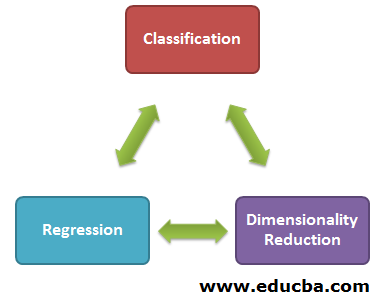
Introduction to Types of Machine Learning
The following article provides an outline for Types of Machine Learning. Machine learning is the subfield of AI that focuses on developing computer programs that can access data by allowing a system to learn and improve automatically.
For example, finding patterns in the database without human interventions or actions is based upon the data type, i.e., labeled or unlabelled, and the techniques used for training the model on a given dataset. Machine learning is further classified as Supervised, Unsupervised, Reinforcement, and Semi-Supervised Learning algorithms; these learning techniques are used in different applications.
What is Machine Learning?
Machine learning is a small application area of Artificial Intelligence in which machines automatically learn from the operations and finesse themselves to give better output. The machines improve the computer programs aligning with the required output based on collected data. Owing to the ability of a machine to learn on its own, explicit programming of these computers isn’t needed.
However, it has already seeped into our lives everywhere without us knowing. Practically every machine we use and the advanced technology machines we are witnessing in the last decade have incorporated machine learning to enhance the quality of products. Some examples of machine learning are self-driving cars, advanced web searches, and speech recognition.
Difference Between Conventional Programming and Machine Learning
Conventional programming = Logic is programmed + Data is inputted + Logic gets run on the Data + output.
Machine Learning = Data is inputted + Expected output is inputted + Run it on the machine for training the algorithm from input to output; in short, let it create its own Logic to reach from input to output + Trained algorithm used on test data for prediction.
Machine Learning Methods
We have four main types of Machine learning Methods based on the kind of learning we expect from the algorithms:
1. Supervised Machine Learning
Supervised learning algorithms are used when the output is classified or labeled. These algorithms learn from the past data that is inputted, called training data, run its analysis, and use this analysis to predict future events of any new data within the known classifications. The accurate prediction of test data requires large data to understand the patterns sufficiently. By comparing the training outputs to the actual ones and using the errors, you can further train the algorithm.
Real-Life Example:
- Image Classification – We derive the algorithm by feeding it labeled image data. We train an algorithm with the expectation that it will correctly classify a new image.
- Market Prediction – It is also called Regression. Historical business market data is fed to the computer. Then, we use analysis and a regression algorithm to predict the future price based on variables.
2. Unsupervised Machine Learning
We use unsupervised learning algorithms when we do not know the final outputs and do not have classified or labeled outputs at our disposal. These algorithms study and generate a function to describe hidden entirely and unlabelled patterns. Hence, there is no correct output, but it studies the data to give out unknown structures in unlabelled data.
Real-Life Example:
- Clustering – The algorithm instructs data with similar traits to form groups, and we refer to these groups as clusters. These are useful for examining these groups, and the findings can more or less apply to all the data within a cluster.
- High Dimension Data – High dimension data usually is not easy to work with. With the help of unsupervised learning, visualization of high-dimension data becomes possible.
- Generative Models – After your algorithm analyzes the input and determines its probability distribution, you can use it to generate new data. This proves to be very helpful in cases of missing data.
3. Reinforcement Machine Learning
This type of machine learning algorithm uses the trial and error method to churn out output based on the highest efficiency of the function. We compare the output to identify errors and provide feedback to the system to enhance or maximize its performance. While the model strives to achieve a specific goal, it receives rewards – essentially feedback and punishments – during its operations.
4. Semi-Supervised Machine Learning
These algorithms typically handle both labeled and unlabeled data, with the volume of unlabeled data usually exceeding that of labeled data. It works with both and between supervised and unsupervised learning algorithms, so it is called semi-supervised machine learning. Systems that use these models demonstrate improved learning accuracy.
Example – An image archive can contain only some of its labeled data, e.g., Dog, cat, mouse, and many images remain unlabelled.
Models based on the Kind of Outputs from the Algorithms
Below are the types of Machine learning models based on the kind of outputs we expect from the algorithms:
1. Classification
There is a division of classes of the inputs; the system produces a model from training data wherein it assigns new inputs to one of these classes. It falls under the umbrella of supervised learning. Spam filtering serves as a real-life example, classifying emails as “spam” or “not spam.”
2. Regression
The regression algorithm is also part of supervised learning, but the difference is that the outputs are continuous variables, not discrete.
Example – Predicting house prices using past data.
3. Dimensionality Reduction
This type of Machine Learning is related to analyses of inputs and reduces them to only relevant ones for model development. To better understand dimensionality reduction, you need to explore further feature selection, which includes input selection and feature extraction.
Considering the approaches mentioned above, evaluating and considering different algorithms is essential. Some common algorithms are Linear and Logistic Regression, K-nearest neighbors, Decision trees, Support vector machines, Random Forests, etc. With the help of these algorithms, complex decision problems can have a sense of direction based on a huge amount of data. Providing additional resources, time, and opportunities is necessary to achieve this level of accuracy and to seize opportunities. Therefore, machine learning, with Artificial intelligence and other technologies, is more effective in processing information.
Recommended Articles
This has been a guide to Types of Machine Learning. Here we discussed the concept of types of Machine Learning along with the different methods and different kinds of models for algorithms. You can also go through our other suggested articles to learn more –





